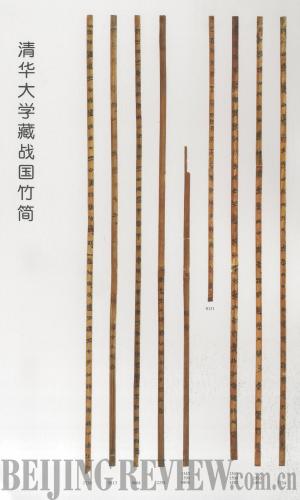|
 |
|
WONDERMENT: Visitors appreciate the bamboo strips donated to the Tsinghua University (XINHUA) |
China's prestigious Tsinghua University recently released preliminary results of research on a rare collection of ancient bamboo books donated to the university by an alumnus in July 2008. The results appear in Tsinghua University's Collection of Warring States' Bamboo Strips (1), a book released at the end of 2010.
The Center of Unearthed Documents Study and Preservation of Tsinghua University was set up specifically to translate and research the bamboo documents after the donation.
Center director Li Xueqin, a renowned historian in China, said all the bamboo documents in their collection dated back to the Warring States Period (475-221 B.C.). They were originally written in ancient characters from the State of Chu, one of the seven kingdoms of the period, which was located in what is now Hubei Province. He said more than 60 documents have been identified and interpreted by the research team.
Bamboo strips, connected by thread, were used for writing before the invention of paper. Sometimes wood was used in place of bamboo.
The recently published book contains nine documents, including eight that appear to be missing parts of the ancient classic Shang Shu, Book of History, a collection of ancient historical documents said to be compiled mainly by Confucius (551-479 B.C.). The original Book of History included more than 100 documents. However, after Emperor Qinshihuang of the Qin Dynasty (221-206 B.C.) ordered all historical texts burned, many important parts of the great book were lost.
The Tsinghua book includes a document entitled Bao Xun, which contains the last words of Emperor Wen, the first ruler of the Zhou Dynasty (1066 -256 B.C.), to his successor. The story had been lost to history for more than two millennia. Another document, Qi Ye, describes the battle of Emperor Wu, the second Zhou emperor, against another kingdom. The document has great historical significance since it helps resolve a long-standing dispute about when the battle occurred.
The ninth document in the Tsinghua book, Chu Ju, is the longest among the Tsinghua bamboo collection. It narrates the history of the State of Chu, introducing the genealogy of the kings and the capitals of the state. It also recounts migration routes of Chu people and reasons behind the move of capitals. It provides much information about Chu culture and will be very helpful to historians researching the history and geography of the ancient kingdom.
|

|
|
TREASURE: A page from the Tsinghua book of the bamboo documents (FILE) |
Warring States Period
The Warring States Period (475-221 B.C.) was a time of great upheaval. Many states of the previous Spring and Autumn Period (770-476 B.C.) disappeared due to consolidation of power by regional kingdoms, bringing great social change. During this period, many schools of thought contended for intellectual dominance. However, the overriding intellectual trend was for political reform and unification.
The Warring States Period ended when the State of Qin unified the entire country after conquering its six rival states, and established the Qin Dynasty (221-207 B.C.).
Agriculture, industry and economy developed quickly during the Warring States Period. The use of iron tools marked a revolutionary innovation in tools and helped increase productivity.
| 